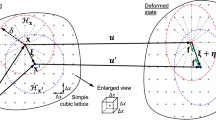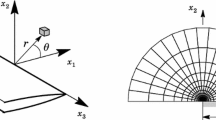Abstract
Based on the existed results of stress field solutions, in the present work a modified dual parameter J∼Q fracture criterion is proposed for plane strain state, and the criterion may be suitable to both homogeneous material and welded joint. Center cracked welded plate in plane strain condition is selected as a research object. Combined with finite element analysis, discussions are made on the engineering estimate and measurement of the various parameters. The engineering algorithm on the various factors in the fracture criterion is also proposed. Referring to the HRR results, it is indicated that the new criterion can describe stress field nature of homogeneous material and welded joint in plane strain state well. The availability of the new proposed criterion to the homogeneous material and welded joint is discussed. Thereafter, the difficulty of the single parameter J-integral can be overcome, when the modified J-integral parameter is used to describe the stress field intensity of plane strain and weld joint. Thus, the new criterion may be a good basis for engineering evaluation of fracture of welded structures.
Similar content being viewed by others
References
Barnby, J.T., Shi, Y.W. and Nadkarni, A.S. (1984). On the void growth in C-Mn structural steel during plastic deformation, International Journal of Fracture 25, 273–283.
Chen, B.S., and Ma, W.D. (1989). Elastoplastic fracture parameters for a joint containing a transverse crack in the longitudinal overmatched weld. Advances in Fracture Research, ICF7, Vol.1, (Edited by K. Salama, et al.), Pergamon press, Oxford, 299–305.
Fu, J.Q. (1996). Study on the characteristics of crack tip field and fracture parameters in welded joints. PhD Thesis, Xi'an Jiaotong University, Xi'an.
Fu, J.Q. and Shi, Y.W. (1996a). Effect of cracked weld joint and yield strength dissimilarity on crack tip stress triaxiality. Theoretical and Applied Fracture Mechanics 25, 51–57.
Fu, J.Q. and Shi, Y.W.(1996b). Mechanical heterogeneity and validity of J-dominance in welded joints, The 2nd International Symposium on Mis-Matching of Welds. Paper No. MM96-22, Reinstorf-Luneburg, Germany.
Li, X, Wang, T.C. and Shih, C.F. (1993). Higher-order analysis of crack tip fields in elastic power-law hardening materials. Journal of the Mechanics and Physics of Solids 41, 665–687.
Ma, F.S. and Kuang, Z.B. (1995a). Stresses deformation and porosities in standard fracture specimens. Acta Metals 42, 497–507.
Ma, F.S. and Kuang, Z.B. (1995b). Microscopic model of ductile fracture and its action in constraint. Acta Mechanics 27, 121–124.
Ma, W.D., Xu, X.X., Tian, X.T. and Goldak, J.A. (1989). Influence of the material inhomogeneity of overmatched welded joints on the crack driving force. Advances in Fracture Research, ICF7, Vol.1, (Edited by K. Salama et al.), Pergamon Press, Oxford, 479–486.
McMeeking, R.M., and Parks, D.M. (1979). On criterion for J-dominance of crack-tip field in large-scale yielding. ASTM STP668, 175–194.
O'Dowd, N.P. (1995). Applications of two parameter approaches in elastic-plastic fracturemechanics. Engineering Fracture Mechanics 52, 445–465.
O'Dowd, N.P. and Shih, C.F. (1991). Family of crack-tip fields characterized by a triaxiality parameter. structure of fields. Journal of the Mechanics and Physics of Solids 39, 989–1015.
O'Dowd, N.P. and Shih, C.F. (1992). Family of crack-tip fields characterized by a triaxiality parameter. fracture applications. Journal of the Mechanics and Physics of Solids 40, 939–963.
Schwalbe, K.H. (1992). Effect of weld metal mis-match on toughness requirements: Some simple analytical considerations using the Engineering Treatment Model (ETM). International Journal of Fracture 56, 257–277.
Schwalbe, K.H. (1993). Welded joints with non-matching weld metal-crack driving force considerations on the basis of the Engineering Treatment Model(ETM). International Journal of Fracture 62, 1–24.
Sham, T.L. (1991). The determination of elastic T-term using higher order weight functions. International Journal Fracture 48, 81–102.
Sharma, S.M. and Aravas, N. (1991). Determination of higher-order terms in asymptotic elastoplastic crack tip solutions. Journal of the Mechanics and Physics of Solids 39, 1043–1072.
Shi, Y.W., Han, Z.X. and Fu, J.Q.(1998). Effects of weld strength undermatch on fracture toughness of HAZ notched weldments in a HSLA steel. International Journal of Fracture 91, 349–358.
Shih, C.F. and German, M.D. (1981). Requirements for a one parameter characterization of crack tip field by the HRR singularity. International Journal of Fracture 17, 27–43.
Shih, C.F., Germam, M.D. and Kumar, V. (1981). An engineering approach for examining crack growth and stability in flawed structure. International Journal of Pressure Vessels and Piping 9, 159–196.
Thaulow, C., Paauw, A.J., Hauge, M., Toyoda, M. and Minami, F. (1994). Fracture property of HAZ-notched weld joint with mechanical mis-matching (part 2), Mis-matching of Welds, ESIS 17 (Edited by K.H. Schwalbe and M. Kocak), Mechanical Engineering Publications, London, 417–432.
Toyoda, M., Minami, F., Ruggieri, C., Thaulow, C. and Hauge, M.(1994). Fracture property of HAZ-notched weld joint with mechanical mis-matching (part 1), Mis-matching of Welds, ESIS 17 (Edited by K.H. Schwalbe and M. Kocak), Mechanical Engineering Publications, London, 399–415.
Varias, A.G. and Shih, C.F. (1993). Quasi-static crack advance under a range of constraints-steady-state fields based on a characteristic length. Journal of the Mechanics and Physics of Solids, 41, 835–861.
Zhang, J.X., Shi, Y.W. and Tu, M.J.(1989). Studies on the fracture mechanics parameters of weldment with mechanical heterogeneity. Engineering Fracture Mechanics 34, 1041–1050.
Zhang, M. (1997). Studies on engineering treatment method of assessing the integrity of welded structures containing defects. PhD Thesis, Xi'an Jiaotong University, Xi'an.
Author information
Authors and Affiliations
Rights and permissions
About this article
Cite this article
Shi, Y., Sun, S. & Zhang, M. On dual-parameter fracture criterion of welded joints. International Journal of Fracture 105, 295–309 (2000). https://doi.org/10.1023/A:1007605100604
Issue Date:
DOI: https://doi.org/10.1023/A:1007605100604




